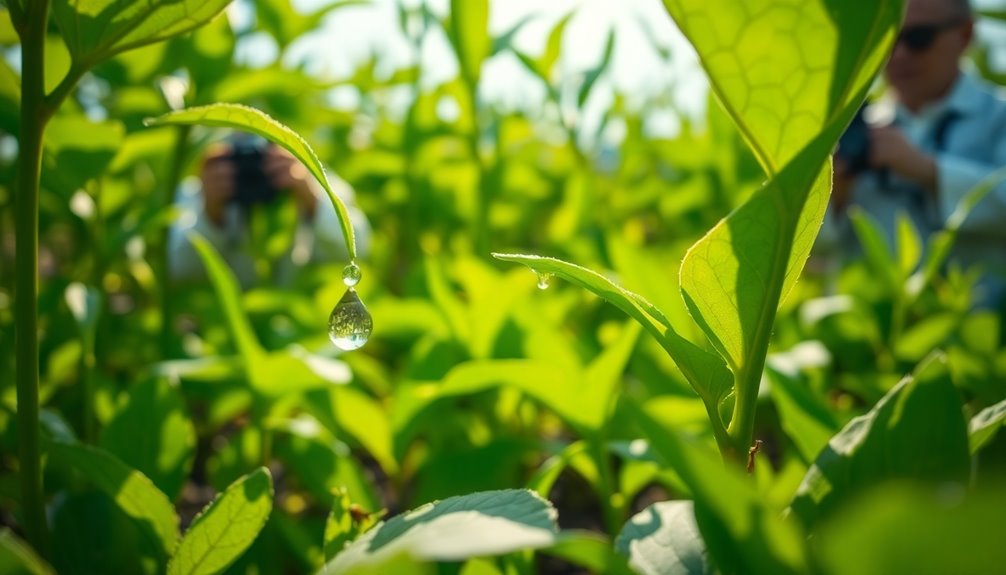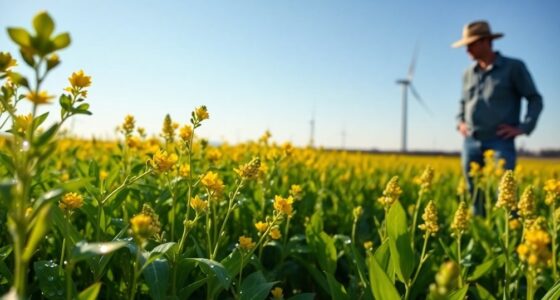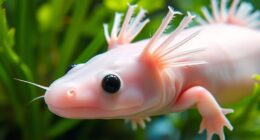Recent discoveries in pest management are shifting the agricultural landscape towards greener practices. Farmers are adopting innovative techniques like intercropping and biological controls, which enhance natural pest resistance and boost soil health. These sustainable methods not only reduce reliance on harmful pesticides but also improve crop resilience and profitability over time. As you explore this topic, you'll uncover even more strategies that could further revolutionize how we approach pest-plant interactions in agriculture.
Key Takeaways
- Innovative pest management techniques, like intercropping, create habitats for natural enemies, enhancing pest control and reducing chemical reliance.
- Elicitors such as tetranins can boost plants' natural defenses, offering a promising avenue for sustainable pest management.
- Biological control methods introduce beneficial insects, providing an effective alternative to chemical pesticides in agriculture.
- Healthy soils improve pest resistance, emphasizing the importance of soil management practices in sustainable farming.
- Integrated pest management combines various strategies, promoting resilience and efficiency while reducing environmental impact in farming systems.

In a world where pesticide overuse has led to alarming pest resistance, you might wonder how farmers are adapting to this challenge. You'll find that many are turning to innovative and sustainable methods to combat pests without relying heavily on chemicals.
Intercropping, for instance, has gained traction as it enhances pest control by creating habitats for natural enemies. This technique not only improves soil health but also boosts biodiversity, which is essential for a balanced ecosystem. Additionally, complementary intercrops allow for efficient nutrient and water extraction from various soil layers, optimizing resource use among different plants.
Intercropping enhances pest control, fosters biodiversity, and improves soil health, vital for a balanced ecosystem.
You might be intrigued by strategies like push-pull trap cropping, which minimizes pesticide use. By employing repellent plants to push pests away and trap crops to draw them in, farmers can effectively manage pest populations while maintaining crop health. This method has proven adaptable to various crops, making it an appealing choice for many growers.
Moreover, the economic implications of these sustainable techniques are significant. Although the pesticide industry is valued at $60 billion, the environmental and health costs are daunting. By embracing practices like companion planting and cover crops, farmers can reduce reliance on pesticides, ultimately lowering their costs and increasing profitability over time.
As you explore more about pest management, consider the role of soil health. Building healthy soils through organic matter and cover crops enhances pest resistance in crops.
Techniques using elicitors, like tetranins from spider mites, are also emerging, boosting plants' natural defense responses. Farmers are focusing on biological control by introducing beneficial insects to manage pests, reinforcing the importance of integrated pest management.
Intercropping not only provides structural complexity but also helps crops adapt to climate change, ensuring resilience under environmental stress.
Frequently Asked Questions
How Can Farmers Implement These Discoveries in Their Practices?
You can implement these discoveries by integrating advanced organic pest control methods into your farming practices.
Start using microbial pesticides and pheromone traps to manage pests while protecting beneficial insects.
Utilize drones for precise crop monitoring and apply AI-driven tools to predict pest outbreaks.
Incorporate routine scouting and mulching to maintain crop health and reduce pest pressure.
What Specific Pests Are Being Targeted in These Studies?
You'll find that several specific pests are being targeted in current studies. For instance, researchers focus on Barnyardgrass, the Lesser Grain Borer, and both the Tobacco Cutworm and Fall Armyworm.
Additionally, they're exploring effective strategies against the Rice Blast Fungus.
By developing innovative control methods, like using essential oils or biopesticides, you can effectively manage these pests while promoting sustainable agricultural practices.
Embracing these findings will enhance your pest management efforts.
Are There Any Risks Associated With These Pest-Plant Interactions?
In the delicate dance between pests and plants, you might find risks lurking in the shadows.
While some interactions bolster plant defenses, they can also backfire, creating pest reservoirs or increasing competition that limits productivity.
You'll notice that beneficial insects may be impacted by environmental changes, and reliance on them could lead to unexpected pest outbreaks.
Balancing these dynamics is crucial for sustainable agriculture, where every decision weighs heavily on your crops' future.
How Does This Research Impact Organic Farming Methods?
This research significantly impacts your organic farming methods by enhancing pest management strategies.
You can utilize insights from plant-pest interactions to improve crop resilience, reducing reliance on chemical pesticides. By integrating biological elicitors, like tetranins, you boost plant defenses naturally.
Additionally, understanding pest resistance helps you adopt more effective practices, such as companion planting and integrated pest management, promoting a healthier ecosystem while ensuring sustainable agricultural practices for the future.
What Funding Sources Support This Innovative Agricultural Research?
Imagine planting seeds of innovation and watching them bloom with funding!
You can tap into various sources for agricultural research. The US Department of Agriculture provides significant grants, while private sector players like AgTech companies offer investments.
State and local initiatives also support local needs. Don't forget crowdfunding platforms, allowing you to engage the public in your projects.
Conclusion
In the battle between pests and plants, the discovery of innovative strategies is like finding a hidden key that unlocks the door to sustainable farming. By embracing these breakthroughs, you're not just planting seeds; you're sowing hope for a greener future. Picture lush fields flourishing without harmful chemicals, where nature thrives in harmony. As you cultivate this knowledge, you're paving the way for a revolution in agriculture, transforming challenges into opportunities for a healthier planet.









